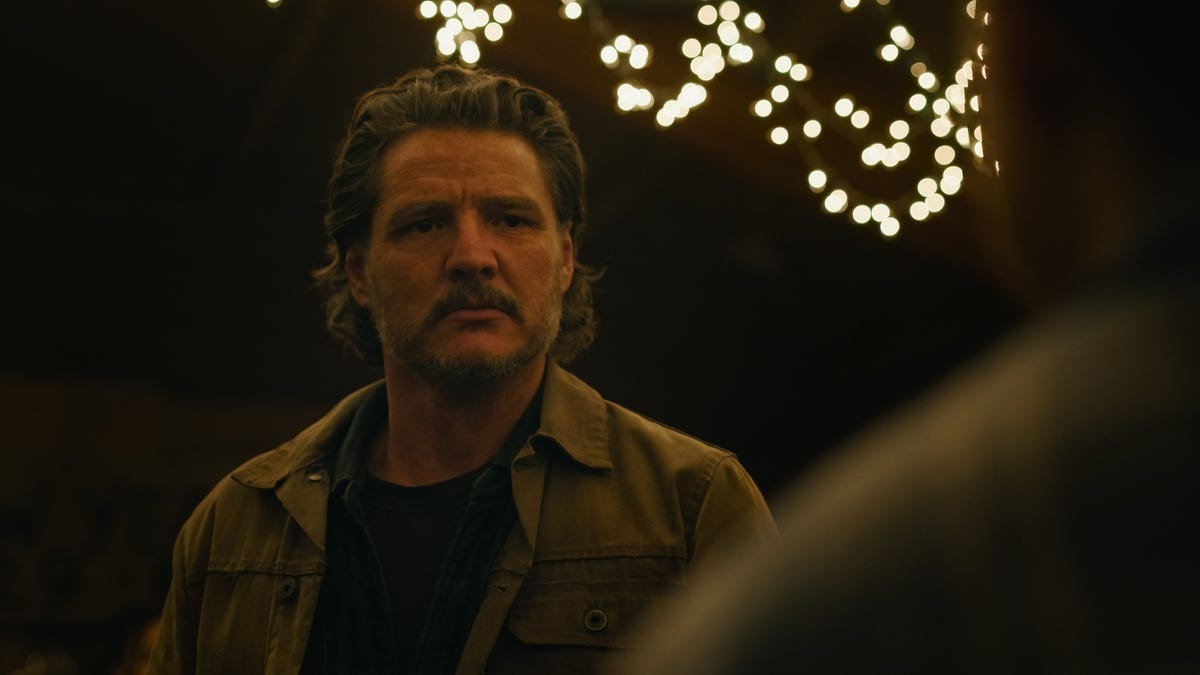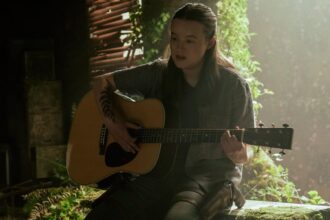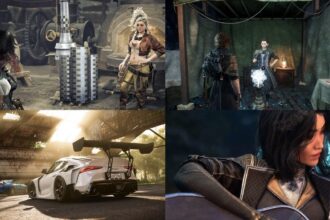“Future Days,” the first episode of The Last of Us season two, opens with the closing moments of season one. Joel (Pedro Pascal) and Ellie (Bella Ramsey) are standing on a hill with the Jackson settlement they’ll call home in the distance. Ellie, unconvinced by Joel’s story about raiders massacring the Firefly revolutionaries who were looking to make a cure for the cordyceps fungus, asks the smuggler to swear that everything he said is true. Joel hesitates and then says that he swears. However, rather than keeping the now-iconic hard cut to black on Ellie’s skeptical face as she says “okay,” season two shows her walking down the hill and leaving Joel in an uncomfortable silence. This unnecessary addition to a scene that was once perfect is a pretty concise encapsulation of the season’s biggest problems. But it’s hardly the most egregious example in this episode.
Unfamiliar faces
The first “new” scene shows Kaitlyn Dever as Abby standing with her friends and fellow ex-Fireflies over a few dozen makeshift graves. She tearfully watches the same giraffe pack that Joel and Ellie stood in awe of days prior, grazing through the remains of Salt Lake City. HBO hasn’t played coy with Abby’s role in the season like Naughty Dog did ahead of The Last of Us Part II, but I was surprised at how quickly the show just tells you up front about her intentions.
As Owen (Spencer Lord), Mel (Ariela Barer), Nora (Tati Gabrielle), and Manny (Danny Ramirez) all discuss what their next steps are, prioritizing their safety and survival above all else, Abby has other ideas. She wants to find Joel, and she wants to kill him “slowly” for what he’s done to the Fireflies. She puts a pendant around one of the crosses, implying some personal connection to one of Joel’s victims, before we cut to black. Already, The Last of Us struggles to elegantly add to Part II, seemingly in a misguided effort to add clarity to a story that has, historically, lent itself to several different interpretations. Withholding those reveals until later in the story was not just a narrative trick in The Last of Us Part II that allowed it to twist the knife mid-game; it also helped generate a core tension foundational to the story being told. Two scenes in, The Last of Us is stripping away the tantalizing and uncomfortable mystique of the original story, but it doesn’t have anything to offer in its place. Dever commits to Abby’s rage and delivers the lines with conviction, and her friends’ hesitant compliance comes across well enough. There’s just a strange, stilted awkwardness to the actual script that the actors can’t shake.
Notably, most of the writing credits for The Last of Us’ second season go to Craig Mazin, one of the showrunners of the series, alongside series director Neil Druckmann. Druckmann and Part II narrative lead Halley Gross have writing credits on the final two episodes of the season, but the bulk of the seven-episode run has Mazin as the sole writing credit. I have to wonder how the writers’ room conversations went down when it came to rearranging these reveals for television and why the show tosses subtlety aside for a blunt, inelegant script in which people just say what they’re thinking to the camera. Abby was once a woman of few words, but Dever’s version tells the room what she’s feeling without a moment’s hesitation. This isn’t a problem exclusive to her in this show, but it was surprising that this tendency was put on such obvious display not once, but twice in the first five minutes.

A community worth fighting for
Suddenly, The Last of Us jumps forward five years, as Part II did before it. We find a tattooed Ellie sparring with a man twice her size and gaining the upper hand until he taps out. Ellie doesn’t let him out of her grip until Jesse (Young Mazino) snaps her out of her bloodlust. Jesse coaches her, and reveals that he told her sparring partner to pull his punches. Ellie takes offense to this, and it becomes a thread throughout the season that the men around her in Jackson are taking steps to shelter her from the violence she seems to crave.
I’ve written at length about how I don’t like the show’s portrayal of Ellie as a person who enjoys the act of violence rather than just someone who believes strongly in the meaning behind it, but season 2’s handling of this thread is so uneven that it’s impossible to unravel just in this first episode. Seeing her tendency toward violence portrayed as a reaction to her being overly sheltered and protected and simply wanting to prove herself is preferable to season one’s notion that she’s just an inherently sadistic person, but The Last of Us is unsure of where this inclination comes from, so we’ll be untangling this messy thread as we track Ellie’s violent spiral throughout the season.
As Ellie leaves the gym, we get a shot of the Jackson, Wyoming, settlement she and Joel have lived in for five years. It’s a pretty accurate recreation of Part II’s version of the small town, with citizens all working together to survive in a post-apocalyptic world. Ellie doesn’t seem convinced by the arrangement, however. She scoffs at the notion of “community” and being part of something bigger than herself. Ellie certainly didn’t seem happy in Jackson in Part II, but again, the show doesn’t care for subtlety and instead has added a new layer of discontent to her arc this time around.
I hesitate to put this solely on Ramsey, given they are working with the material they’ve been given, but their more youthful performance of Ellie doesn’t work in the character’s favor. Yes, Ramsey is technically older than the 19-year-old Ellie, but where Ashley Johnson’s performance in the games gave Ellie the air of a dejected loner struggling to accept a life she wasn’t content with, Ramsey’s comes off as bratty and childlike. I have trouble buying their performance in even the most neutral of scenes, much less the weightier moments to come.
Pascal, meanwhile, is daddying his daddiest dad self as Joel, doing handyman shit while entertaining Dina (Isabela Merced), Ellie’s close friend in Jackson. While I think many of the show’s departures from the game are for the worse, I welcome this one. Dina and Joel have basically no interaction whatsoever in Part II, and having the two be close in the show gives both actors an opportunity to shine, and makes up for some of the structural changes the show makes that have condensed Pascal’s role a bit this season. This scene lets Joel be more than the violent smuggler he’s often viewed as, and lets us see him as just a gruff older man trying desperately to connect with the youth. Much of Joel’s legacy in The Last of Us is paved in violence, but when you get him in safe living conditions with more mundane problems like circuitry and teen angst, he’s the embodiment of an oblivious, well-meaning southern dad. “Girl, the war crimes.” I know, I know, but he’s also babygirl.
But even this nice moment of Joel throwing out some circuitry jargon (whatever you say, beautiful) is cut short by Dina asking what’s up with him and Ellie. Why are these two on the outs, and why does no one else seem to know why? Joel chalks it up to teen angst and rebellion against her father figure. Again, HBO’s The Last of Us loves to codify feelings and questions in the most overt way possible, and somehow, it dives straight into the debate about the surrogate nature of Joel and Ellie’s relationship that fans have been having for years in a way that is surprisingly much more explicit. Joel says he’s her parent, but in a later scene, Gail explicitly says he is not. “I figure it’s normal,” Joel says to Dina. “Her being 19 and me being her…what I am. No one likes their parents at that age. I never got there with my own kid, so we’re both just figuring it out for the first time, is all.”
Perhaps it’s just my preference for the game’s sparse exploration of these ideas that makes me raise my eyebrows at these changes. Many of The Last of Us’ script tweaks feel like they’re rooted in a need to course-correct public perception or acknowledge fan discourse. Joel and Ellie have what feels like a familial relationship, but so many online arguments regarding Joel’s actions against the Fireflies have been rooted in whether or not they were “actually” family. Does Joel have the right to save Ellie from a lethal surgery if he’s not “really” her father? Can you claim the seemingly almost genetic inclination Ellie has toward retribution comes from Joel if she’s not “actually” his daughter? These matters were never even in consideration for Joel and Ellie before, but suddenly, it’s a concern for this version of the characters after years of discourse made it one. In a vacuum, it’s fine. In the big picture of the franchise, it feels manufactured, like the writers deliberately inserting a community discourse into the minds of characters who never once cared about it.
Sure, maybe I’m comparing Pascal and Ramsey’s versions of these characters to the originals too much. Still, part of watching an adaptation is wondering what, if anything, is gained and lost in translation. The Last of Us is trapped so rigidly within the confines of the specific story the games tell that every deviation, for good and ill, bears more scrutiny. Compare it to something like the Halo series, which tells an entirely different story, or the new Devil May Cry anime that reboots the whole continuity. It’s easier to just get on the ride and see what new riffs a team comes up with. The Last of Us show has been so tied up in faithfully recreating what Mazin believes is “the greatest story ever told in video games” to a new audience that every time there is a change in the way these characters talk to each other, I have to wonder what Mazin’s team thinks is gained in this expository approach. Am I wrong for thinking that if someone is mostly sticking to the old script but makes notable changes or additions, they think there’s something to be improved upon in the source material? Were those more restrained interactions something Mazin viewed as a weak point in The Last of Us Part II’s storytelling, or is it a kneejerk reaction to the way people talk about it?
These problems aren’t inherently the medium of television’s fault, but the show certainly has different priorities than the games it’s based on. Whenever Joel, Ellie, Abby, or anyone else pulls subtext out of the ground like the cordyceps roots some workers find infesting the piping of Jackson, it feels oddly condescending, like someone at HBO thinks viewers wouldn’t be smart enough to pick up any of this on their own.
At any rate, Joel claims he’s not sure what he did to deserve Ellie’s ire, but he’s working on himself in the meantime by going to therapy. Ellie is doing some therapy of her own, sniping infected off Jackson’s border with Joel’s brother Tommy (Gabriel Luna). At the behest of his brother, Tommy has removed Ellie from the patrols that take out infected in the areas surrounding Jackson, and our funky little lesbian is less than thrilled. She’s the only person in the town who’s immune to the cordyceps infection, so in theory, Ellie should be fighting at the frontlines of the infection. But her immunity is a secret. Tommy shushes her when she brings it up, so she then starts shouting it to anyone in a one-mile radius. Again, a reaction that might’ve fit the spritely 14-year-old Ellie in season one but feels out of place for the more world-weary 19-year-old Ramsey is meant to be in this season.
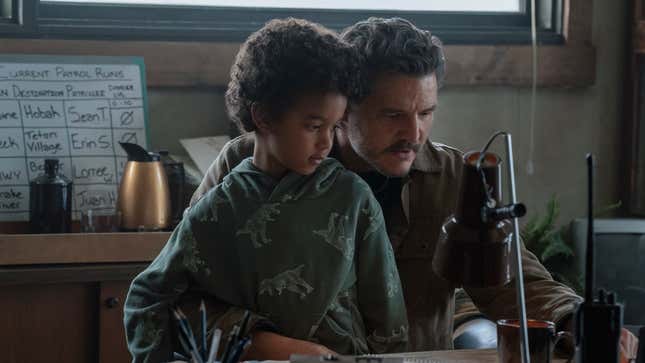
Back in Jackson proper, Joel and his sister-in-law Maria (Rutina Wesley) are working on city planning as new refugees enter the enclosure. Maria’s painfully aware that despite her best efforts, Jackson can’t accommodate the number of people coming in looking for food and shelter. The town has buildings, restaurants, infrastructure, and even a governing body, but even the most coordinated mutual aid effort eventually rubs up against the reality of an apocalypse. Maria is idealistic. She believes that she owes it to those in need to help, but Joel says that if the lifeboat is swamped, you leave them outside.
“You’ve gotta look after your own first, or you’re no good to anyone,” he says casually. I’m sure this was his rationale when he murdered dozens of Fireflies to save Ellie, but Maria judges him from across the room. Then, in comes a brand new character for the show: Tommy and Maria’s son Benji. Joel puts him on his knee and shows him a town map, playfully talking about shooting the “monsters” beyond the wall. Maria’s stare softens, as she’s clearly moved by the sentiment when her child is in front of her. The Last of Us has always positioned family, found or otherwise, as something that shifts one’s perspective, whether toward selflessness or selfishness. So, I’m curious to see how the show wields Benji when it comes to Tommy and Maria’s actions in the future. However, even if she hears Joel, Maria leaves him with the thought that he was a refugee once, too, which he acknowledges with a knowing nod.
Working on yourself
Joel heads to therapy with Gail (Catherine O’Hara), another character made whole cloth for the show. The first season made a big to-do about Joel’s anxiety (another thing that was mostly just implied in the games), so giving him a therapy sideplot feels like the natural next step in the arc. The old man is visibly uncomfortable in Gail’s home. Initially, this comes off as him being unhappy to be doing some self-work, but it quickly becomes clear why he might feel some type of way in this house specifically. Gail offers him tea or whisky before their session starts, then partakes in the latter herself. It’s her birthday, the first without her husband Eugene in 41 years. Game fans will know Eugene as an ex-Firefly who died of old age shortly before the events of the game, but the show has taken some creative liberties with his history.
Gail reveals that Joel shot and killed her husband, and she hates him for it. Surely it must be more complicated than that if he’s sitting in her home right now. All we know is that Joel “had no choice” and that Gail’s issue is less that Joel murdered Eugene than it is his methods. She expresses all this resentment as a means to pull the same kind of raw honesty out of Joel, who she suspects is holding back in their sessions. Probing into the obvious divide between him and Ellie, Gail asks Joel if he hurt her, to which he tearfully shakes his head. Then he stands up and simply says, “I saved her,” before walking out. Stubborn and sure of himself as ever.
Of all The Last of Us’ new additions, I probably feel most conflicted about Gail. O’Hara is a charismatic delight as always, and having someone who isn’t scared to call out Joel Miller is a refreshing dynamic. But when the show’s biggest writing problem is a tendency toward unnaturally expositional dialogue that sounds like it’s coming from a YouTube explainer, having a character whose role is to make people talk about their feelings could easily exacerbate the issue. There’s a danger that, rather than Joel and Ellie simply having a traumatic experience, they’ll have to explain it to Gail like a book report, analyzing their lives like a text. Joel’s vague confession here isn’t that overt, but after seeing some of the earlier scenes in the episode, Gail’s presence already makes me wary.
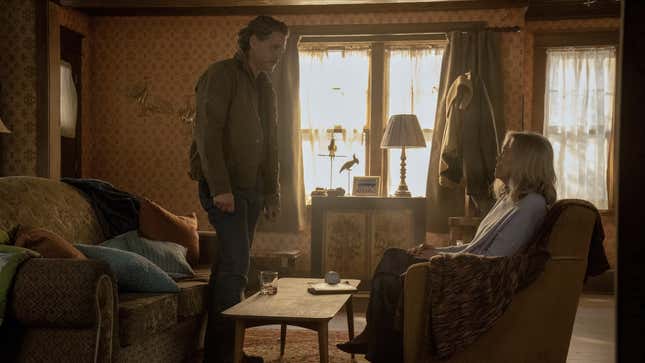
A first date to die for
We then shift over to Ellie’s home, a furnished garage in Joel’s backyard. The space is a nearly perfect recreation of her little hut in The Last of Us Part II, complete with Savage Starlight posters, retro music tapes, and the tobacco sunburst acoustic guitar with the moth decal on the fretboard. I’ve always loved Ellie’s tiny corner of Jackson because it says so much about her, both in the game and the show. Covered in nerdy paraphernalia from a time she can only dream about, Ellie’s room is a nostalgic time capsule for a life she never got to live. Most of the collectibles and swag she’s gathered over the years are here because she managed to stumble upon them in her and Joel’s journey. Her collection of comics and music was salvaged like any bandage or shiv taped together to help them survive. I don’t doubt that she loves the intergalactic adventures of Dr. Daniela Star, but I also find her attachment to one particular comic fascinating because I wonder if the tastes of kids in this world develop organically or if it’s just about whatever they find when rummaging in dusty drawers and shelves. Ellie’s room is built like a scrapbook, things chosen from whatever she finds lying around, to which she imparts special significance.
That is all much more apparent in the game, as the show doesn’t linger in Ellie’s home for very long. We do get a cool shot of her doing some gun maintenance, which feels like an homage to Part II’s elaborate gun modification animations whenever you upgrade your gear. Then the camera lingers on Ellie’s tattoo, which covers up a chemical burn where her bite mark used to be, but more on that later. Dina shows up and helps Ellie get ready for their patrol before fishing for more info on her and Joel’s little spat. Ellie doesn’t take the bait, though Dina doesn’t strike me as someone to give up that easily.
The pair collect their horses, including Shimmer, the MVP of The Last of Us Part II (if you know, you know), and meet up with Jesse for patrol assignments. There’s palpable tension between the girls and Jesse, who comes off less like a protective older brother to Ellie and more like a jilted, condescending one. Not that those things are mutually exclusive, and perhaps it works better this way considering Ellie’s more young and reckless inclinations in this version of the story. Jesse is a leader in this community, and when you have someone who seems to be jaded toward the very notions of community and responsibility, perhaps it makes more sense for the two of them to be at odds.
Joining Ellie and Dina on this horse ride is Kat, another character who is only mentioned in Ellie’s diary entries in Part II as her first girlfriend in Jackson. That history remains true in the show, with Dina playfully telling Ellie she should take Kat to the town’s New Year’s dance. She’s “the other one” in Jackson, meaning that yeah, the queer community in this settlement is pretty small, and there seems to be some taboo around it. We’ll unpack this more as the season goes on, but I do feel for Ellie in this moment, being essentially paired off with the one other young lesbian in town just because there’s no one else. Every queer person has a story of a well-meaning friend telling you they have someone they think you should meet and it just happens to be the only other gay person in their orbit. It probably feels even worse when the person saying this to you is a friend you’re obviously crushing on. Dina catches on that Ellie’s got the hots for someone else and offers to go with her as friends, revealing that she and Jesse have broken up (again, for now). Shoot your shot, Ellie.
The patrol then stumbles upon a gnarly crime-scene-like spectacle of infected corpses strewn around outside an abandoned supermarket, but hey, you should see the other guy. A bear’s remains are at the center of all the carnage, and its guts are hanging out of its body. The grisly (sorry) sight doesn’t deter the two lovebirds as they head into the old grocery store to take out whatever infected stragglers may be lurking within. Despite their flirtatious unseriousness, Dina and Ellie are more than capable of fucking up a group of infected. Merced and Ramsey are fun together as they joke around even in dire circumstances. The actual fight scene between the two and the infected stragglers is full of some cute nods to the games, like Ellie using a glass bottle to distract one of the beasts and then jumping on its back and frantically stabbing it, similar to her stealthy finishing move from Part I. Which, again, also illustrates that Ramsey sure doesn’t feel like the older Ellie of Part II. But it is what it is.
After taking out one clicker, Ellie falls through the floor to a lower level, and while she thinks she’s alone, it’s only because the infected down here is smart enough to hide. These stalkers are another kind of infected alongside the runners and clickers everyone’s used to. They can sneak, hide, and strategize in a way most infected can’t. Seeing the stalker successfully outsmart and outrun Ellie is pretty terrifying. Bill once said in Part I that infected were easy to deal with because they were predictable, and now Ellie’s finding out that might not be true any longer.
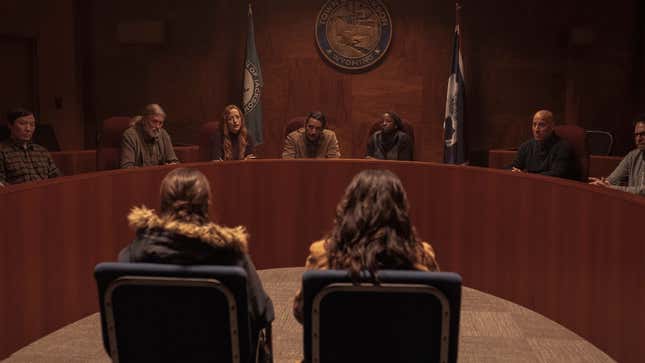
Ellie gets bit in the scrap but hides it from Dina because that’s easier than explaining the whole immunity thing. Speaking of difficult things, Ellie does have to explain this new infected to Tommy, Maria, and the rest of a Jackson council. Scene for scene, the Last of Us show spends more time in Jackson than Part II does, so it makes sense that HBO would take this opportunity to delve into the inner workings of how the settlement operates. We knew Maria calls the shots, but it’s nice to know big decisions are made by a committee. There are some hints of division, though, with some suspecting the cluster of infected found in and around the grocery store could indicate a larger infected horde on its way, while others remain skeptical.
We then get a scene that delves into part of Ellie’s life I hadn’t considered before, and is one of the more interesting moments in the episode that were created just for the show. In order to keep her immunity secret, Ellie has to cut herself further to make the bite mark less apparent, then stitching it like any other wound. She doesn’t go to a medical professional, instead sanitizing her switchblade and making do. Given that the show has changed how the infection works to no longer be airborne, I was curious how season two would handle illustrating Ellie’s immunity, and how she maintains the lie was an interesting bit of specificity that answered a question I hadn’t previously thought about.
Bridges burned
After she cleans the wound, Ellie starts jotting down notes about her day in her diary, another nice homage to Part II in which Ellie periodically writes her innermost thoughts in an old notebook the player can flip through. It’s the closest thing Ellie has to an internal monologue throughout the game, and it was certainly a better way of getting insight into her thought process than the more expository dialogue of the show. Those little glimpses into Ellie’s mind felt like they were written for her, and we just got a chance to read them and maybe gain some greater understanding of the violent conquest we were on. Meanwhile, the show’s dialogue in which Ellie expresses those feelings to someone else feels written for an assumed audience. Sure, all dialogue is written with an assumed audience, but masking that is not the show’s forte.
Joel shows up and asks if Ellie’s heading to the dance tonight, and it’s clear there’s tension between the two of them that neither wants to acknowledge outright. Joel does what he does best and insists on doing something for her despite her protests, pointing out that her guitar’s strings need changing and leaving with it.
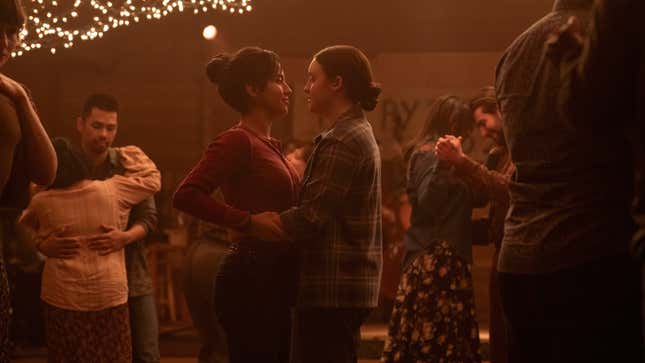
Next, we see one of the best scenes in all of The Last of Us Part II: the dance, a sequence so good in the game that I was really glad to see the writers largely left it alone here. Dina dancing to Crooked Still’s “Little Sadie,” Ellie being a wallflower on the sidelines, and then the extroverted friend rushing to the introverted one and pulling her onto the dancefloor. The exchange between the two as Crooked Still’s “Ecstacy” plays in the background is still one of my favorites in the series. Every line is meticulously thought out, illustrating Ellie’s insecurity and Dina’s flirtatious confidence, and watching those two feelings collide in a kiss is downright electric. God, what a perfect fucking scene, right down to the moment when Seth (Robert John Burke), the town bigot, interrupts to throw a slur onto the dance floor in front of dozens of people. But in comes Ally of the Year Joel to knock him on his ass. Ellie lashes out and tells Joel she doesn’t want his help, so he leaves with his tail between his legs. Ellie is regretful but also clearly embarrassed by the scene that Seth and Joel just made.
As she heads back home, she sees Joel on his back porch, playing the restrung guitar. They lock eyes briefly before Ellie walks past him without stopping. Game fans know that scene goes down a bit differently, and I was genuinely shocked not only to see Joel sitting on that porch in the first episode but also to see Ellie walking past him without a word. By this point, I wasn’t sure what to make of this; the conversation that Joel and Ellie have on that porch is foundational to the story of The Last of Us Part II, so when I saw this deviation in “Future Days,” I was more intrigued by it than anything else in the episode because I wondered how HBO’s adaptation would make up for not including it. But that’s a question for another episode, I suppose.
For now, we end “Future Days” with the citizens of Jackson in danger, both from inside and outside the settlement. The Cordyceps fungus is spreading in the pipes, and Abby and Owen are shown just outside the town’s border. It looks like this quiet, small-town refuge is about to become a battleground.
The Last of Us airs on Max, Sundays at 9 p.m. Eastern.
